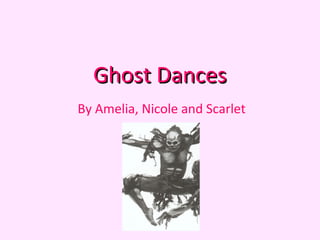
Ghost dances
- 1. Ghost Dances By Amelia, Nicole and Scarlet
- 2. The Choreographer Christopher Bruce • He was Born on October 3rd 1945 in Leicester, England. • Christopher Bruce trained at the Rambert ballet school. • Christopher Bruce received a Evening Standard Inaugural Dance Award in 1974. Christopher grew up in Scarborough where his father encouraged him to take classes in Christopher Bruce has a position of ballet and tap. He won a scholarship to the Britain’s leading choreographer working Ballet Rambert School at the age of 13 and with both classical and contemporary after a brief period with Walter Gore’s companies worldwide. London Ballet he joined Ballet Rambert in 1963.
- 3. Costume Belinda Scarlett • Dehumanised skeletal creatures • Skull masks • Matted hair • Near naked bodies painted with water based make up to outline muscle groups and emphasise bone structure. • Apart from their masks and body paint, the Ghost Dancers’ costumes consist of black bands of loose rags and feathers round their waists, upper arms, wrists and just below their knees. • Skull like masks covers the full face Hair and feathers attached
- 4. Staging and Lighting The Staging • it is based on North and South America and the set is a very spooky place resembling abandonment. It is set at night and starts of with skeleton like creatures on stage. • Christopher designed his own stage setting for Ghost dances. Lighting • The lighting was designed to be very effective in which it focuses on the movements and actions of both people and ghosts. • The lighting was done by a man called Nick Chelton.
- 5. Plot and Choreography • South America, at the time Christopher Bruce choreographed Ghost Dances, was a tragic place with terrible things happening to the poorer, common people: fathers taken away from their families and shot or thrown away in cells and tortured to death. Friends were murdered and children taken away. • Ghost Dances has a cruel relentless quality about it, so when people die they are smashed to the ground cruelly or dragged off by the Ghost Dancers, cruel creatures who symbolise death. Bruce used the influences of the Indian past and created a land – a kind of entrance to the underworld of heaven or hell – where these ghost dancers came from. • Throughout Ghost Dances we see the peasant villagers carrying on their everyday lives, aware that death might at any time, knock on their door and carry them away. • The dance takes on a mixed quality of fun, of trying to be happy knowing of the constant threat of death. The villagers, no matter how much their people are hurt, murdered and taken away, show pride and dignity and seem to accept the murderings as a fact of life.
- 6. Theme Christopher Bruce described that he took the theme of ‘the Day of the Dead’, this dance has simple symbolism and native dance movements as a basis to express the troubles of the innocent people of South American down the ages and their courage in the face of difficulty. Certainly, Ghost Dances has a tremendous impact and audiences in many countries have delighted in its distinctive, rhythmic movement performed to haunting South American tunes.
- 7. So why did Christopher Bruce decide to make ‘Ghost Dances’? • Christopher Bruce decided to choreograph Ghost dances as he wanted to make people aware of the political problems occurring during this era. • He also wanted to show the world in a different way how terrible the Pinochet regime was and how it affected people. • In Ghost Dances the ghosts represent death as they peel off the villagers one by one.
- 8. The Dancers! • In Ghost Dances there are 3 ghosts all of them being male and 8 dead characters (People), 5 women and 3 men.
- 9. The First Performance • Ghost Dances was created for Ballet Rambert and first performed on 3 July 1981 at the Bristol Theatre Royal. • It was nominated for the 1982 Society of West End Theatre Awards as the 'Outstanding Achievement of the Year in Ballet'.
- 10. Music • A Statement from Christopher Bruce - ‘With 'Ghost Dances' I was immediately effected by the South American folk music and this happened to come at a time when I was particularly moved by the situation in Chile so the two elements came together and were the inspiration for 'Ghost Dances'.
- 11. Questions Frequently Asked I know you started dancing with Rambert in 1963 - but what first got you interested in dance - was it ballet, and how old were you? • Christopher Bruce: I think I started to train as a dancer before I was interested in the art form - it was just a weird accident that I went to dance classes. But my interest developed as I studied from the time that I joined the Rambert School in 1959. The atmosphere and artistic heritage permeated the Mercury Theatre and the school and it was an important part of my early development. How would you describe your own style of dancing? • Christopher Bruce: I think my own style was formed largely in the early years of my career when I was training in classical ballet. Later there were other influences But I think this initial period enabled me to develop a very personal way of moving and means of expression
- 12. Thank you :D x